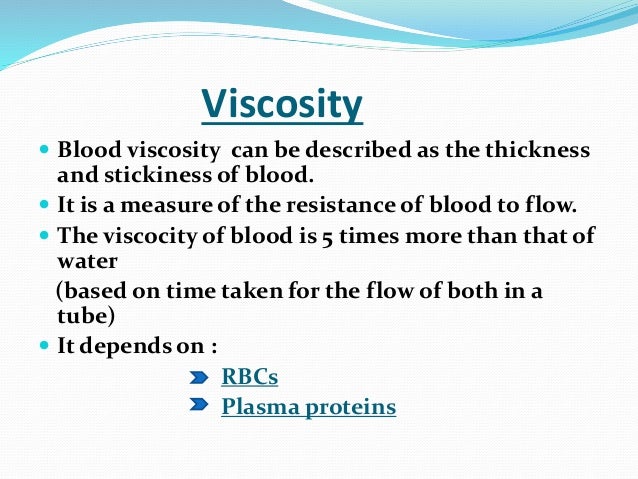

One unit increase in hematocrit can cause up to a 4% increase in blood viscosity. Nevertheless, hematocrit has the strongest impact on whole blood viscosity. Plasma's viscosity is determined by water-content and macromolecular components, so these factors that affect blood viscosity are the plasma protein concentration and types of proteins in the plasma. The primary determinants of blood viscosity are hematocrit, red blood cell deformability, red blood cell aggregation, and plasma viscosity. These functions of the cardiovascular system are directly related to vascular resistance, preload, afterload, and perfusion, respectively. This biophysical property makes it a critical determinant of friction against the vessel walls, the rate of venous return, the work required for the heart to pump blood, and how much oxygen is transported to tissues and organs. It can also be described as the thickness and stickiness of blood. Blood viscosity also increases with increases in red cell aggregability.īlood viscosity is a measure of the resistance of blood to flow. Contrarily, blood viscosity increases when shear rate goes down with increased vessel diameters or with low flow, such as downstream from an obstruction or in diastole. Therefore, blood is a shear-thinning fluid. Blood becomes less viscous at high shear rates like those experienced with increased flow such as during exercise or in peak- systole. As such, the viscosity of blood varies with shear rate. Because of that, blood behaves as a non-Newtonian fluid. Red blood cells have unique mechanical behavior, which can be discussed under the terms erythrocyte deformability and erythrocyte aggregation. Blood viscosity is determined by plasma viscosity, hematocrit (volume fraction of red blood cell, which constitute 99.9% of the cellular elements) and mechanical properties of red blood cells.

Alterations of these properties play significant roles in disease processes. Proper tissue perfusion can occur only when blood's rheological properties are within certain levels. Hemorheology, also spelled haemorheology (from Greek ‘αἷμα, haima ' blood' and rheology, from Greek ῥέω rhéō, ' flow' and -λoγία, -logia 'study of'), or blood rheology, is the study of flow properties of blood and its elements of plasma and cells. ( December 2020) ( Learn how and when to remove this template message) Please help improve this article if you can.

#Increased blood viscosity full
The specific problem is: the article is full of duplicated informations in different sections. The increase blood viscosity noted in the hypoxic and diseased groups could lead to a decreased blood flow and oxygen delivery to the tissues.This article may require cleanup to meet Wikipedia's quality standards. No significant difference was observed among the four groups in mean cell volume, mean cell hemoglobin, and mean cell hemoglobin concentration. The diseased group had a significantly higher PCV than all other groups resulting in a significant increase in blood viscosity. At packed cell volumes (PCV) of 30% and 40% and at high shear rates (75 s -1 and 150 s -1) the hypoxic group had a significantly higher apparent blood viscosity when compared to healthy fish, likely the result of a significant increase in the total plasma protein concentration in this group. Plasma and apparent (whole) blood viscosity measurements were made using a Wells-Brookfield cone/plate viscometer at ten different shear rates. Twenty-seven adult striped bass weighing between 1040 g and 1800 g were divided into four groups: (1) healthy fish (2) short-term hypoxia, fish exposed to oxygen concentrations of 4 mg/L for four hours (3) simulated transport, exposed to crowding with oxygen concentrations of approximately 8.4 mg/L and (4) diseased fish, infected with henneguya causing inflammation of the gill surface leading to hypoxemia in these animals. Blood viscosity and blood parameters were studied in striped bass, Morone saxatilis (Walbaum) under various fish hatchery conditions.


 0 kommentar(er)
0 kommentar(er)
